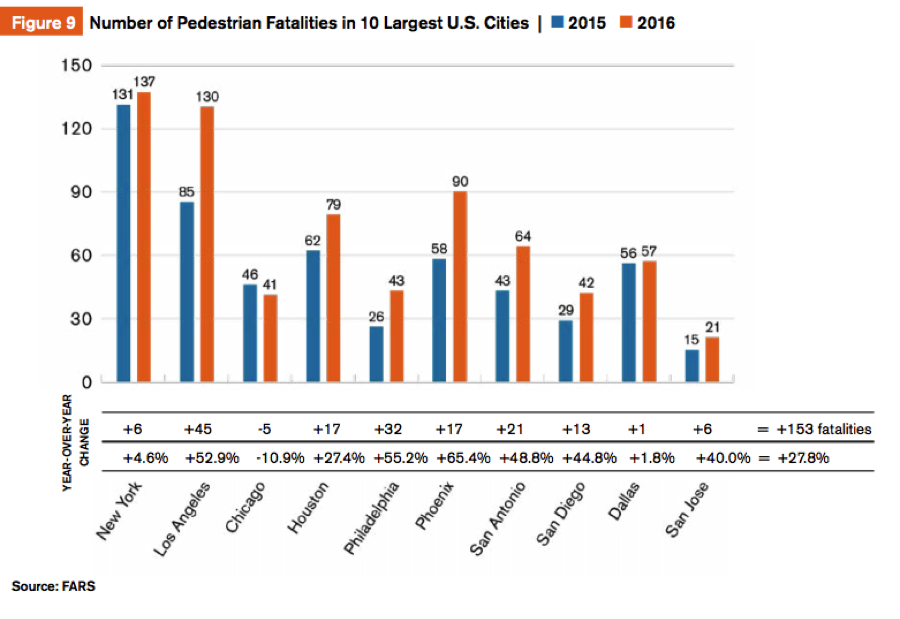March 2, 2018
Over the last decade, pedestrian deaths have been increasing both in number and as a share of all traffic fatalities on US roads. The Governors Highway Safety Association (GHSA) released its annual report on pedestrian traffic fatalities this week with data and analysis on pedestrian deaths in the US in 2016 and the beginning of 2017.
“The number of pedestrian fatalities increased 27 percent from 2007 to 2016, while at the same time, all other traffic deaths decreased by 14 percent”
The Fatality Analysis Reporting System (FARS) data from the last ten years shows that pedestrian deaths as a percent of total traffic fatalities has increased from 11% in 2007 to 16% in 2016. In 2016, most pedestrian fatalities (52%) occurred on highways (either state, U.S., or interstate), and 33% occurred on local municipal streets.

The high proportion of fatalities on highways relates to the statistic that 72% of them occurred away from intersections. 18% occurred at intersections (which are generally scarce along highways), and the rest at non-travel lane locations such as shoulders or driveways.
Breakdowns of pedestrian safety by state show that it is not just the usual suspects when it comes to the recent upswing in pedestrian deaths on a state-by-state level. Pedestrian fatality rates increased across the country, with New Mexico, Florida, and South Carolina holding the highest pedestrian rates at 3.45, 3.22, and 2.96 deaths per 100,000 people respectively.
At a city level, pedestrian fatalities are increasing in large cities across the country. Between 2015 and 2016 the rate of increase of pedestrian deaths in cities (28%) is much higher than for all other jurisdictions combined (9.5%).

The City of Chicago is the only city among the ten largest US cities that did not see a rise in pedestrian deaths, perhaps a testament to the Illinois DOT funding provided to Chicago DOT for pedestrian safety as well as attention to the problem across the City of Chicago with education, planning, and enforcement efforts supporting a Vision Zero program.
“The total number of pedestrian fatalities for the ten largest U.S. cities increased by about 28 percent.”
The report also noted that most pedestrian fatalities occur at when it is dark out, about a third of pedestrians killed were under the influence of alcohol (BAC of .08 or above), and 13% of the drivers involved in fatal crashes were under the influence of alcohol. Vulnerable populations among pedestrians include young people (defined in FARS as 15 years of age and under), and older people (70 and above), who made up 5% and 14% of pedestrian fatalities in 2016, respectively.
The GHSA began a study to examine pedestrian fatalities in the first half of 2017 and estimate little change from 2016, but acknowledge that the data used for the 2017 estimates were incomplete and limited. Nevertheless, the report notes an increase in pedestrian fatalities in early 2017 in states with legalized recreational marijuana (ETW covered USDOT’s campaign against drugged driving last week here), and also draws in data from 2005 to 2016 about cell phone use and messaging ubiquity, suggesting connections between cell phone use and pedestrian fatalities – a trend often discussed but lacking the backing of well-designed studies.
Understanding the traffic safety data available through FARS and other sources can help cites, states, and the federal government decide where to prioritize efforts and funding to save the most lives. Every state DOT is required to employ a full-time bicycle and pedestrian coordinator, but some states have developed much more guidance, planning documentation, and programs to actively work towards a goal of reducing pedestrian fatalities. Some states and cities have adopted Vision Zero, or taken other steps to help work Agencies like NACTO have published guides such as the Urban Street Design Guide that cities can look to.
The federal government also has programs, such as Section 405 and the Highway Safety Improvement Program (HSIP), that states and cities can utilize to fund projects and initiatives that work towards improving roadway safety for pedestrians. Federally required Highway Safety Plans can also give states an opportunity to focus on pedestrian safety. The GHSA report gives an overview of what each state is currently doing in planning, engineering, education, and enforcement to improve pedestrian safety. There is a large range in how much different states are actively collecting and using data, instituting programs, and prioritizing projects towards the goal of reducing pedestrian deaths.





